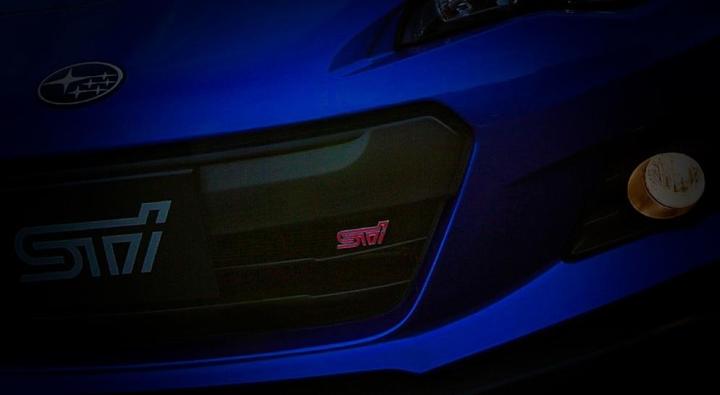
The inevitable has happened. Subaru has released a couple teaser photos of the upcoming BRZ STI. While this is very good news, it’s not the promise of a yet another turbocharged Subaru that has us excited. Rather, it’s the further differentiation of the BRZ from its twin – the Scion FR-S – that has us tickled.
For those who’ve been living under a rock for the last few years, the BRZ and the FR-S are – save a few minor differences – essentially the same car. The two rear-wheel drive economical sports cars are the product of a Subaru and Toyota partnership. Subaru did the designing while Toyota fitted the bill and tacked on the Scion badge.
Although Subaru has been charged with the manufacturing of the twin sports cars, Toyota gets to keep 90 percent of the production run for itself, leaving only a nominal number to be sold as Subaru BRZs. As the years tick on, however, Subaru’s share of the production will dwindle and eventually drop to zero. One day, the BRZ won’t exist at all. Sad, that.
Why would Subaru do such a deal? It was all about technology. Toyota wanted a rear-drive sports car and Subaru wanted a direct fuel injection system. Toyota had the D4-S direct injection system from the Lexus IS-F to spare and Suby had the engineering prowess to get a rear-drive coupe completed. The deal was done.
Subaru, while it can, is going big with its share of the riches. What exactly the upcoming BRZ STI will have under the hood is yet unknown. It’ll likely be a big turbo, though, based upon what we’ve seen of the WRX STI over the years. We know Subaru has the ability to turbocharge the new 2.0-liter boxer four-cylinder, too, as a very similar engine is found under the hood of the new 250hp Forester XT. If I had to guess, I’d wager the BRZ STI will make somewhere in the 280 horsepower range. From there, Subaru will likely stiffen suspension further, add some bigger brakes, and cover the little BRZ with brightly-colored STI badges.
It will surely be quite a kick to drive and an instant classic.

As exciting as it is, though, the BRZ STI doesn’t really matter. It’ll be made in very small quantities and for a very short amount of time. It’ll be a magical car, yes, but it won’t have the impact or staying power of the FR-S. The BRZ is a flash in the pan, a blip on the radar. The FR-S, however, is here for the long haul. So rather than drool over the BRZ STI, let’s instead look at what this turning point means for the future of the FR-S.
Many of us in the automotive media had been speculating since the launch of both the BRZ and the FR-S that forced induction variants would likely follow. I presumed that Suby would turbo and Scion would supercharge. Last week, however, Toyota stated it would not be fitting chargers to the FR-S but instead will likely focus on a hybrid-powered performance model. While this has me rather disappointed, it makes sense and is totally inline with branding: Subaru is known for its turbos and Toyota is known for its hybrids.
Hybrids are still widely seen as doddling little eco machines, despite the existence of the McLaren P1 and the LaFerrari. And Toyota is effectively married to hybridization. In order to propel hybridization to the forefront of the market, of which hybrids only comprise around four or five percent, they need a big boost in popularity. An affordable true sports car with satisfying performance and a hybrid drivetrain would do that trick quite nicely.
Think of it like this: car companies routinely build supercars not for the profits gleaned from the sale of the limited-run supercar itself, of which there are little, but rather because of the attention the high-performance models attract. Few people can afford an Audi R8 but they want to feel like they’re apart of the coolness surrounding an Audi R8. So they go buy an A3 or A4.

The hybrid FR-S, I wager, would have the same benefit but with the addition of drawing attention and buyers to the brand but also prove profitable – unlike supercars.
Should the hybrid FR-S hit the market, though, it wouldn’t be the first affordable sport hybrid. Honda, as you might recall, still makes and ‘sells’ the CR-Z sport hybrid. It was a great idea. But it sadly proved neither sporty nor fuel-efficient. Hybrid FR-S or not, however, Honda has its sights set on Scion. I recently spoke with a Honda representative who said that should Honda go after the FR-S, it could make a much, much better car. He cited the late S2000 as a perfect example of Honda’s rear-wheel drive sports car building prowess. That could prove to be a very, very good Japanese rear-drive sports car battle for us motoring enthusiasts.
Ultimately, that is all thinly-informed speculation at this point. What we do know for sure is that the fated BRZ is getting an STI treatment. And if you’re the kind of driver who can buy a turbocharged sports car and not drive the snot out of it, I’d say start saving for a down payment now. I reckon that in 25 years, a clean BRZ STI will likely be worth its weight in gold.


